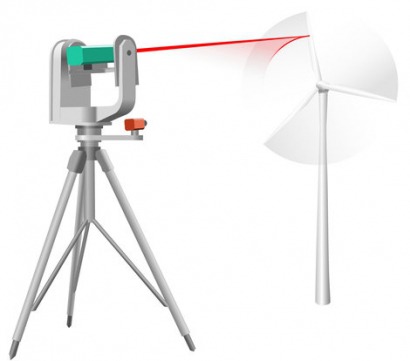
The rotor and most of a wind turbine can oscillate even in normal operation and the analysis of these oscillations plays an important role in the development and maintenance of equipment. Up until now this has only been possible at discrete points located directly on the equipment itself but the Fraunhofer Institute of Optronics, System Technologies and Image Exploitation (IOSB) is now using modern technology to remotely measure the oscillatory pattern over the entire structure of the facility from several hundred meters away.
“Wind turbines oscillate with displacements of up to a meter in magnitude, even at normal wind speeds” said Dr. Ilja Kaufmann from the Optronics Department of IOSB in Ettlingen. “For this reason, operators continuously check how strong the oscillations are by using sensors built into the mast and rotor blades. The disadvantage of this approach is that measurements are only made at the locations where the sensors were mounted. Obtaining a comprehensive oscillatory pattern over the entire installation is impossible using this technology.”
Kaufmann and his colleagues will be presenting a technological system at CeBIT in Hanover from March 10th to 14th, where they will be displaying a prototype of the diagnostics system. Visitors can trace the path of the low-power laser beam’s green dot on the rotor blades of the six-foot wind turbine model at the Fraunhofer booth (hall 9, booth E40). The images from the camera and of the oscillation analyses can be seen on two monitor screens of the system.
The system enables oscillation analysis to be completely carried out from a distance of several hundred meters and consists of a laser that is directed at the installation and able to measure the oscillations at all points on the surface. To accomplish this, the laser automatically tracks the motion of the moving parts like the rotor blades.
The centrepiece of the system is an IT-based tracking system that combines a camera and a laser. These are mounted on a head that can pan and tilt to follow the rotor blades. The camera records images of the installation and forwards these along to software that processes the images and builds a model of the rotary motion from the data. With the help of this information, the pan and tilt head is positioned so that the laser automatically follows the rotor blades. The camera simultaneously collects data about the exact position of the roughly two-to-three centimetre laser spot on the rotor blade in order to stabilize it on the revolving surface. This way, as many points on the equipment as are needed can be scanned during operation – even from a great distance.
The system is compact and can be easily transported to the desired location in a vehicle. Offshore installations can be examined from on board a ship, assuming you can compensate for the ship’s movement.
“Many wind farms in Germany have been running a good 20 years already – often the maximum operating life” Kaufmann added. Operators can use our technology to evaluation their installations. We can provide decision-making assistance for questions like ‘Is it in good enough shape that I can continue to operate it, or should I sell it and build a new one at the same site?’”
In a separate development, the Fraunhofer Institute for High Frequency Physics and Radar Techniques FHR is working with commercial firm Industrial Electronics and the wind farm engineering firm Dirkshof Wind GmbH in order to solve a problem with blinking beacons positioned on top of wind turbines to warn approaching aircraft at night.
Many people are disturbed by these beacons which should only be switched on in instances when the facility is actually approached by an airplane at the corresponding altitude. In this way, the periods when the warning lights are flashing are considerably shortened. In a project named ‘Parasol’ the Institute is developing a system that detects and analyses air traffic in the area of the wind farms based on passive radar sensors. These sensors emit no radar of their own but instead utilize local radio station frequencies to locate airplanes.
The radio station transmitters send out signals that are reflected by the airborne objects. The passive radar sensing system then uses mathematical algorithms to compare the reflected signals with the direct radio station signals it receives. The distance, position, and velocity of the approaching aircraft can be calculated using this comparison.
The system comprises three sensors, each of which consists of an antenna unit attached to the wind turbine mast, and signal processing located within the mast. A CPU in each wind farm for evaluating the data completes the system.
A prototype has already been installed and successfully tested at a wind farm operated by Dirkshof in the town of Reußen-Köge near Husum, Germany. Kuschel and his team are presently optimizing the signal detection algorithms. Parasol is expected to go into operation in 2015.
For additional information:

